Stop Topping The Golf Ball: Fault Fix
Golf tips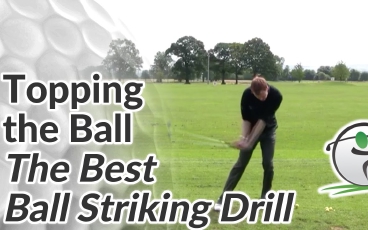
A topped approach shot into the green isn’t usually that destructive,but it’s thoroughly dissatisfying and does little for your confidence. This How To Stop Topping The Ball mini series will help you eliminate topped shots from your golf game.
Topping the golf ball out on the course, in front of your playing partners, can leave you feeling frustrated and even a little foolish.
A topped approach shot into the green isn’t usually that destructive (the ball typically stays straight and can travel a fair distance), but it’s thoroughly dissatisfying and does little for your confidence. Topping the golf ball around the fringes of the green or in a bunker usually does spell disaster.
This How To Stop Topping The Ball mini series will help you eliminate topped shots from your golf game completely.
We’ll assume that a thin shot is just a less severe version of the top shot – so the club strikes towards the bottom of the ball but doesn’t get to the very botom of the ball. Even the best players catch the ball thin from time-to-time and the result is usually a shot that flies reasonably well but comes up short of the target.
Fault 1: Standing up during backswing and downswing
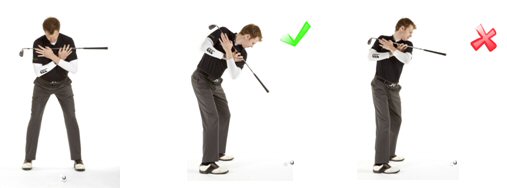 One of the main causes of topping the golf ball is standing up during the backswing and / or the downswing. Even a slight straightening at the hips can cause you to top the ball so it’s really important that you maintain your posture throughout the swing.
One of the main causes of topping the golf ball is standing up during the backswing and / or the downswing. Even a slight straightening at the hips can cause you to top the ball so it’s really important that you maintain your posture throughout the swing.- A great indicator of whether this is happening during the backswing is to hold a club horizontally across your shoulders with the handle pointing towards the target.
- Make your backswing and see where the grip now points to. If you have maintained your correct posture, the handle should point directly to the ball as you complete your 90 degree shoulder rotation.
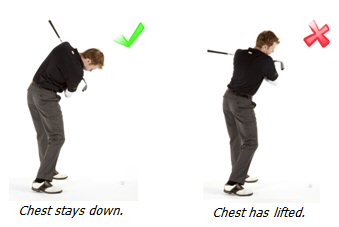 Lifting your chest during the downswing is one of the biggest causes of topping or thinning the golf ball. People often confuse this with lifting the head, but in reality lifting the chest should be of much greater concern to you.
Lifting your chest during the downswing is one of the biggest causes of topping or thinning the golf ball. People often confuse this with lifting the head, but in reality lifting the chest should be of much greater concern to you.- As you make a series of practice swings, feel how keeping your chest down and maintaining your posture from address will help you scuff the ground and start to take a divot. Apply this feeling when you swing at full speed and see how your strikes can improve.
- Watch a video part 1 and part 2.
Fault 2: Bending your arms through impact
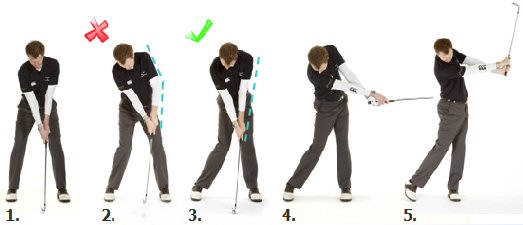 Start by making some smooth slow practice swings, only taking the club to chest height on your follow through. At this height, ensure that both arms remain straight (pictures 4 & 5).
Start by making some smooth slow practice swings, only taking the club to chest height on your follow through. At this height, ensure that both arms remain straight (pictures 4 & 5).- Repeat this exercise until it feels natural to maintain that straight arm follow position, and then start clipping the ball from a tee peg without any real power, again checking your follow through arm position. Gradually, as you gain more confidence, increase your power but always maintaining straight arms past chest height.
- Watch a video here.
The Best Ball Striking Drill
But if you feel that neither of those faults appear in your swing and you’re still topping the ball on a regular basis, this drill will definitely help.
In fact, in my experience, when you master this drill you’ll cut top shots (and fat shots) out of your game almost completely . It’s an excellent exercise to get you hitting the bottom of the ball, creating a clean, crisp strike every time.
A quick word about taking divots…
A lot of golfers that hit topped or thin shots, also hit the ball fat (the club strikes the ground before the ball causing a very poor contact). Many of their thin or top shots are the result of not trying to hit the ball fat.
But striking the turf is an important part of hitting a crisp golf shot… with the aim obviously being to hit the ground after the ball (referred to as ‘ball-then turf’).
When you learn to consistently strike the ground after the ball – what that feels like, how your weight shifts to make that happen – it’s impossible to either hit the ball fat or top it.
And that’s what the following drill will help you achieve.
One of my students, Phil, noticed that before this drill he always tried to ‘clip’ the ball off the ground (as though the club could only make contact with the turf at that tiny spot right under the ball). Now he is able to take a healthy divot without fear of hitting behind the ball or topping it.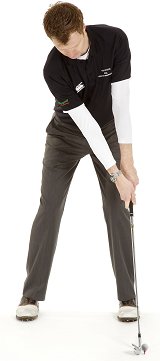
- Place a ball one inch in front of your front foot; it may help if you tee the ball up to start with. Having the ball further forward than you would normally place it with your driver may initially feel very awkward, but stick with it.
- Now go ahead and sweep the ball off the tee and into the air with a nice smooth swing. Really focus on your body weight and how it should move aggressively to the left in your downswing.
- Shifting your hips to the left before impact will mean that when the club strikes the ground it will no longer be behind the ball. This should start to give you more confidence that striking the ground and taking a divot is a very positive part of hitting great golf shots.
- Watch a video here.

